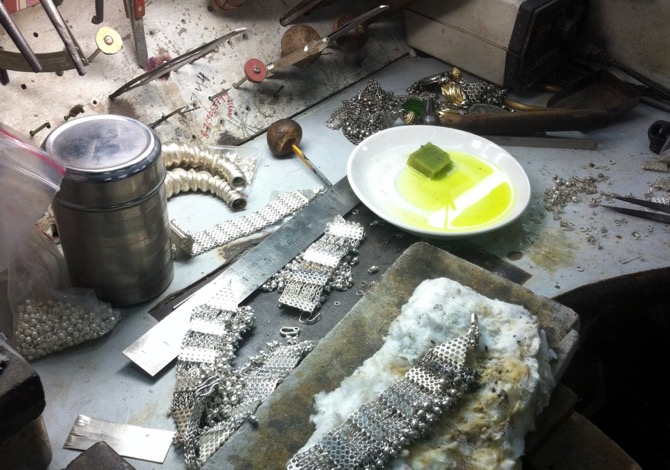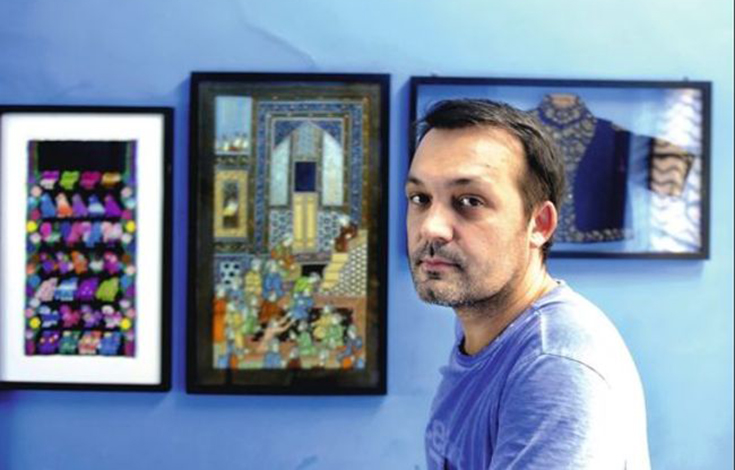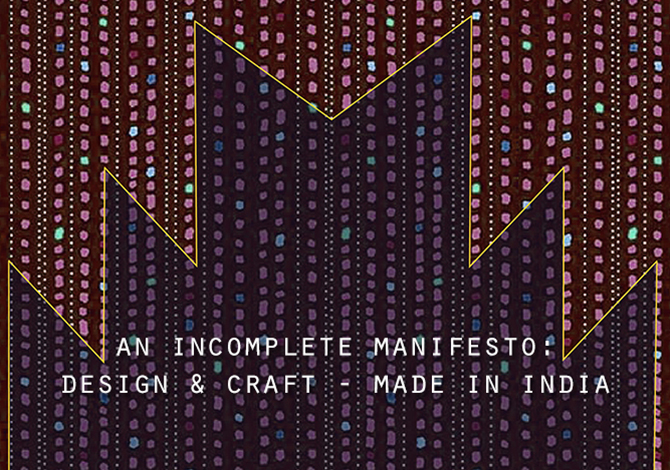Ethical.
Handmade.
Handloom.
Khadi.
Organic.
Silkmark.
Sustainable.
We seem to read, use and speak these words all the time as both makers and consumers. However – dollar to dime ask anyone their definition and the responses – although with best intentions – can be ambiguous, self-regulated, and therefore open to interpretation. Case in point, recent phone call from a Mumbai-based pop-up store asking for our client’s presence at their organic sale. Upon informing them that our client was not using certified organic textile the reply came, “that’s OK – as long as it’s handwoven it’s fine”.
We have spent much time researching for this article to understand what these terms mean for end users (both designers and consumers) and how they are validated and used within the Indian textile and garment industry. Our conclusion? It’s a jungle out there. Why? Information defining terms and certifications is not easy to source – often buried in lengthy online documents or requiring a visit/call to the respective authorized office. The specifics online are convoluted, which makes inferring and appropriating them for practical use difficult and open to inaccuracy.
It is apparent that all the brands we spoke to have the best intentions to work through these shortcomings, and partner with more organizations who can certify their accuracy while providing a reliable and wide range of textiles. What is needed is a clear set of guidelines that are adopted by a critical mass, along with an understanding of how (and how not to) use these terms. In the meantime, there is little choice but to develop individual understandings and try to implement them the best way possible.
It is worth noting that India’s largest ‘sustainable’ lifestyle brand declined commenting on this article as they are currently working on internal definitions of these terms. Thank you to those who did – Abraham&Thakore, Anita Dongre, Ekaya, Rashmi Varma and The Summer House – it is by engaging in a dialogue that we can endeavour to change, finding a common way forward that benefits us all.
The United Nations 2005 World Summit on Social Development defined sustainable by identifying three goals for sustainable development: economic development, social development and environmental protection. These three pillars have served as common ground for many sustainability standards across the world.
The closest thing to a sustainable certification is Eco Mark, launched in 1991 by the Government of India. It certifies all products (including textiles) as environmentally friendly if they are “made, used or disposed in a way that significantly reduces the harm it would otherwise cause to the environment”1.
Issuing of Eco Mark is a long-drawn process that involves multiple steps under a broad 3-step-process of identification, review and assessment by three different committees.
Note: We do not have a single certification standard covering both natural and human ecology aspects of sustainable textile production. Eco Mark only takes into account the effect of a product on nature and not on humans.
On the ground >
The Summer House > We define being sustainable as making responsible choices that do minimum damage to the earth every step of the way. We do not define ourselves as a sustainable brand – we only define the clothing that we know has been produced in the most responsible way it could have possibly been made, as sustainable clothing. We do not take this definition lightly and do not tag just everything with it.
Anita Dongre > Sustaining crafts via giving employment is our way of adding to the sustainable economy.
Rashmi Varma > We try to work as much as possible with hand-craft and handloom, as one step towards sustainability. Our responsibility towards our employees is to ensure they earn livable wages.
The Silk Mark certifies pure silk products with the following definition: “natural silk is a continuous protein filament secreted by silk worms. It has natural sheen, inherent affinity for rich colours, high moisture absorbance, poor heat conduction, low static current generation, resilience, is lightweight and has an excellent drape.2 The Silk Mark is for weavers, co-operatives of weavers or other yardage supplying organisations, not necessarily a brand itself.
This certification requires an application, followed by an on-site or product verification, anonymous checks by the authority to see if guidelines are being adhered to and finally, granting of certification and silk mark tags. Our visit to Angika, a Varanasi-based Cooperative Society revealed hundreds of Silk Mark tags in boxes. This does not imply misuse – rather, the gap between receiving tags upon certification rather than quality checks for each piece. This can also help illustrate why consumers and makers do not uphold it as a foolproof benchmark for the purity of silk.
On the ground > Brands seem to rely on self due diligence. Larger brands seem to value the mark more, as it resonates amongst a larger mass audience.
Abraham & Thakore > We do not require a silk mark on our fabric. We source from known providers and also frequently send fabrics for lab testing both for quality requirements as well as structural data.
Anita Dongre > We do not use silk mark.
Ekaya > We are in the process of getting a silk mark certification. We use genuine silk in our products. A silk mark would help in boosting the confidence of the customer in believing in the quality of our product.
Handloom is defined by the Ministry of Textiles as “any loom operated manually” but also makes a section for “other looms” including semi-automatic looms i.e. Chittaranjan looms, Ichalkaranji looms and modernised Malabar looms.3 To assure uniformity in quality of handloom products, in 2006 the Ministry of Textiles introduced the Handloom Mark scheme.4 The Handloom Mark is for weavers, co-operatives of weavers or other yardage supplying organisations, not necessarily a brand itself.5 However shortcomings include a lack of rigour in assessment and can lead to mislabeled textiles, similar to the Silk Mark scheme.
On the ground > Designers/brands largely rely on their own resources, knowledge and instinct to assess a handwoven textile.
Abraham & Thakore > We have the technical resources and training to assess a handwoven textile.
Anita Dongre > We closely follow our weaving production. A majority of our fabric is handwoven.
Rashmi Varma > We can tell from looking at the weaves – handloom weaves have slight inconsistencies. We also show them to experts for a second opinion.
Ekaya > We have been certified by the ministry as an Indian Handloom Brand. We know our product is made through handloom because of our diligent supervision and close quality control.
Craftmark, established in 2006, certifies genuine Indian handicrafts and defines handmade/handcrafted process as “any process where the hand skills of the practitioner are the most significant part of the production process.”6
Similar to Silk Mark and Handloom Mark, it’s meant for weavers, co-operatives of weavers or other yardage supplying organisations and not necessarily a brand itself. The process to obtain Craftmark involves filling out an application, inspection by an authorized officer, random checks every three months and eventually, the certification.
On the ground > Irrespective of the Craftmark certification, for designers, craft witnessed and supervised being done by hands is “handmade” in the true sense.
Anita Dongre > Handmade work is done on our premises and our team works with the artisans, onsite.
Rashmi Varma > Many of the handmade elements we use are made right in our studio. We also source from trusted suppliers of handloom.
Khadi Mark is the certification for pure khadi in India. Launched by the Ministry of Textiles in October 2013, Khadi Mark defines genuine khadi as “hand spun and hand woven, containing natural fibres (cotton/wool/silk) produced in India.”7 In addition, pure khadi must come from “persons and certified khadi institutions producing, selling or trading in khadi and khadi products.” However, this does not account for a differentiation in khadi spun entirely by hand, versus that on an ambar charka – a debate amongst many purists.
The Khadi Mark too, is for weavers, co-operatives of weavers or other yardage supplying organisations and not necessarily a brand itself. Obtaining Khadi Mark follows a similar procedure as Silk Mark, Handloom Mark and Craftmark – applying for the certification followed by checks and verifications by authorised personnel. A note that there are questions from textile experts about the purity of khadi from The Khadi and Village Industries Commission (KVIC) – but that is for another article.
On the ground > Largely, designers and brands have the same interpretation of pure khadi as that stated by Khadi Mark. Additionally, they ensure use of pure khadi in their garments by procuring the fabric from sources such as Khadi Gram Udyog.
Anita Dongre > We go by Khadi Mark definition – 100% khadi is handspun and handwoven.
Abraham & Thakore > Though true khadi is defined as fabric woven with handspun yarn, we use ambar charkha yarn in some of the khadi we use.
The Summer House > Our khadi is woven by Khadi Gram Udyog that has the Khadi Mark, and mainly hires women in need.
Rashmi Varma > We use khadi bought directly from Khadi Gram Udyog, so we know it’s pure – 100% handspun and 100% handwoven.
The Indian Standard for Organic Textiles (ISOT), launched in 2012 by National Programme for Organic Production, certifies a textile as “organic” if it “contains 95% certified organic fibre and is subsequently treated as per this standard. The 5% non-organic content could be composed of regenerated and manmade fibre.” ISOT also has another, more lenient definition i.e. “If the organic fibre content is less than 95% but more than 70% in the final product, the textiles should be labelled as ‘made with organic fibre’”.8
Certification by ISOT involves assessing and certifying each step in the handling of the product – from fabric to production units, storage, packaging and transportation to ensure integrity of the “organic” textile. These are certified based on quality parameters laid down by ISOT itself.
On the ground > Reliance on the source of procurement of the organic fabric is seen among designers and brands.
The Summer House > Our organic fabric comes from a fabric that is GOTS certified. (Note: The GOTS is the global standard for organic textile certification whose genesis lies in not just listing hazardous chemicals used in production of non-organic fabric but also explaining linkages between these substances and their social and ecological repercussions.9 The ISOT on the other hand focuses on mentioning which chemical substances should be avoided to meet eligibility for organic certification without elucidating their impact on environment and human beings.)
Rashmi Varma > We use some fabrics, kala cotton for example, that is organic. We’d like to use more such.
The Indian textile industry has no overarching certification for “ethical” textiles.
Instead, brands who are exploring ethical and sustainable fashion look to the definition given by EFF – an industry body for sustainable fashion representing over 10,000 members in 100 countries.10
EFF defines ethical fashion as “an approach to the design, sourcing and manufacture of clothing which maximises benefits to people and communities while minimising impact on the environment. The meaning goes beyond doing no harm, representing an approach which strives to take an active role in poverty reduction, sustainable livelihood creation, and minimising and counteracting environmental concerns.”11 It has four defining criteria: Fair Trade, Eco Mark, Organic and Recycling/Re-use.
How is this practically applied in India? > India has multiple certification schemes, each addressing EFF’s four defining criteria:
Fair Trade: Fair Trade India certifies products that “focus on improving labour and living conditions for farming communities and promoting a way of farming that protects people and the environment.”12
Eco Mark: Eco Mark (administered by the Bureau of Indian Standards) certifies products which are “made, used or disposed of in a way that significantly reduces the harm it would otherwise cause the environment”.13
Organic: Indian Standards for Organic Textiles (ISOT) defines “organic” as “textile that contains 95% certified organic fibre and is subsequently treated as per this standard. The 5% non-organic content could be composed of regenerated and man-made fibre.”14
Recycling/Re-use: A few independent certifying agencies operational in India certify recycled and re-used products – though not textiles alone. Ecocert India certifies textile as recycled if the textile is (a) made of a minimum of 70% natural and/or recycled fibre (b) defines an environmental policy requiring water and energy savings (c) uses dyes and manufacturing processes that respect the environment and health of consumers and (d) keeps in line with the main international conventions on social, health and safety, and working conditions. Ecocert also requires clear labelling of textile products in terms of composition to maintain transparency with the consumer.15
On the ground > The lack of a set, defined meaning and governing body of “ethical” leaves designers/brands who are consciously in the “ethical” fashion space to form their own interpretations of the word and what it includes:
Anita Dongre > For us “ethical” mainly, and most importantly, means cruelty free. It also implies fair wages and so, we work closely with established NGOs to source the craft through them.
The Summer House > Some of our fabric vendors are Fair Trade certified. But in honesty, we do not actively look for it as we understand it is an expensive certification for small set-ups.
Rashmi Varma > We ask as many questions as possible about how, where and what in terms of process, materials used and finances involved. We try to visit suppliers and producers to see their work conditions. If it (weaver/producer/production process) does not sit well with our conscience, we look for other options. At the studio we make sure our employees are provided with a safe, clean and well-lit working environment.
Have more clarity than we do? Please let us know in the comments below.
________________________
References:
- Eco Mark, Ministry of Environment and Forests, Govt of India, http://envfor.nic.in/legis/others/ecom ark.html
- Silk Mark India, http://silkmarkindia.com/
- Ministry of Textiles, GoI, Handloom Census of India, 2009-10, pp.6-8, http://handlooms.nic.in/Writereaddata/Handloom%20report.pdf
- The Hindu, “‘Handloom mark’ scheme introduced”,pub. March 9th, 2011 http://www.thehindu.com/news/cities/Tiruchirapalli/handloom-mark-scheme-introduced/article1523228.ece
- Khadi and Village Industries Commission, Ministry of Micro, Small and Medium Enterprises, GoI, “List of institutions to whom khadi mark registration certificates issued” www.kvic.org.in/update/circulars/CCC_Instn.doc
- Craftmark, “Seal of Authenticity”, http://www.craftmark.org/craftmark-seal-authencity
- Khadi Mark Protocol, Pg 8, http://www.kvic.org.in/update/circulars/SO-1724-Final.pdf
- Indian Standards for Organic Textiles (ISOT), p.6 http://apeda.gov.in/apedawebsite/organic/ISOT_Textiles_Standard.pdf
- The Global Organic Textile Standard”, Version 4, March 2014, http://www.global-standard.org/images/GOTS_Version4-01March2014.pdf
- Ethical Fashion Forum, “About EFF”, http://www.ethicalfashionforum.com/about-eff
- Ethical Fashion Forum, “What is Ethical Fashion”, http://source.ethicalfashionforum.com/article/what-is-ethical-fashion
- Fair Trade India, “Products”, http://fairtradeindia.org/products/wholesale-products/
- Eco Mark, Ministry of Environment and Forests, Govt of India http://envfor.nic.in/legis/others/ecomark.html
- Indian Standards for Organic Textiles (ISOT), p.6 http://apeda.gov.in/apedawebsite/organic/ISOT_Textiles_Standard.pdf
- Ecocert India, Ecological and Recycled Textiles, http://www.ecocert.in/organic-ecological-recycled.html
Disclaimer: Rashmi Varma is a client of the Border&Fall Agency.











As a clothing label working with artisan communities on handcrafts and forever trying to explain customers/ media the definition of sustainability, khadi, ethical and so on, this article comes as a great insight. thanks for sharing the details on various certifications available.
A Big thank you to your team for sharing this great “valuable” article, every one is using these terms with very superficial knowledge, and Exporters, textile manufactures, specially retail traders are using them and misleading customers…thanks again…looking forward for more such article 🙂
Great article clearly defining the overbearing words. These words are being used indiscriminately by the brands and designers to raise the prices of their products. Hope customers will now question and understand the claims before paying the price.
Heritage weaves is a weaver’s initiative which is sustainable, handmade, uses silkmark and ethical too. http://www.heritageweaves.com